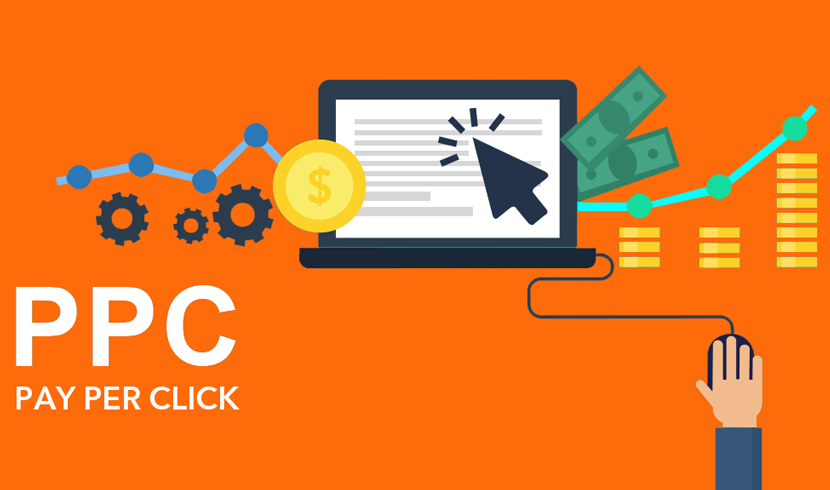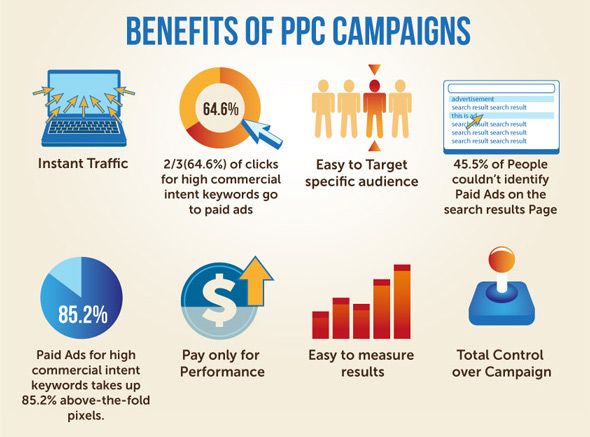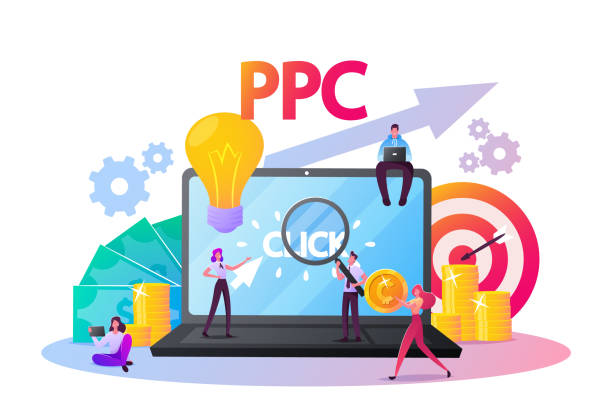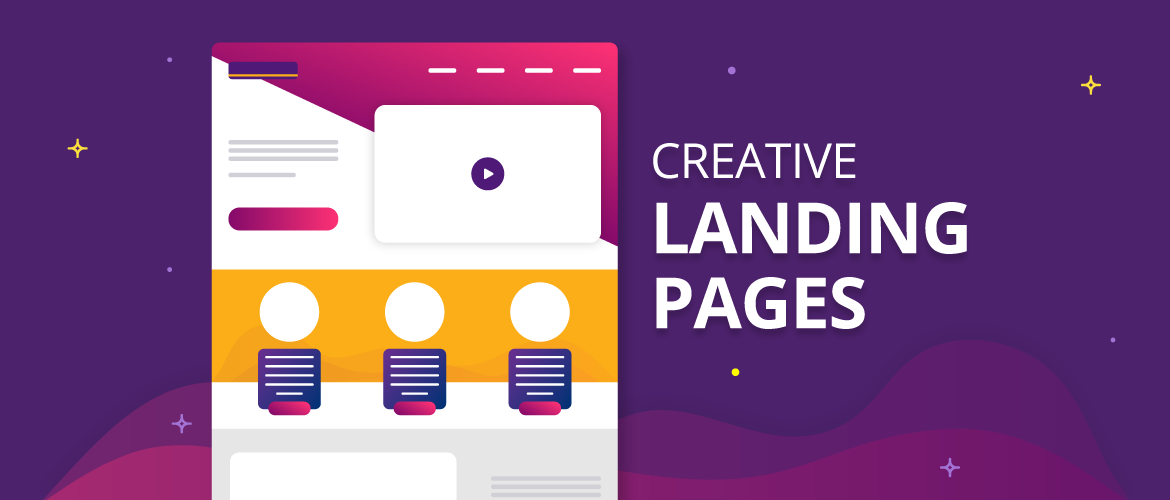Hello Digital learners, In this Blog we will be covering everything you need to know about PPC Ad . so, let's get started with this guide.
Pay-per-click (PPC) online advertisers are those who charge for each click on their advertisements. It is a method of advertising that is extremely targeted and allows you to reach your target market affordably. Due to its ability to connect businesses with potential clients at the ideal moment, with the ideal message, and on the ideal platform, PPC advertising is growing in popularity.
1. How Does PPC Advertising Work?
PPC advertising works on a bidding system where advertisers bid on keywords that are relevant to their target audience. The search engine shows the highest bidder's advertisement in the search results when a user searches for a term that the advertiser has bid on.The advertiser only pays when the user clicks on their ad, hence the name Pay-per-click (PPC). The bid amount, ad quality, and the ad's relevancy to the user's search query all affect how much the advertiser spends per click.
2. Types of PPC Advertising
There are three main types of PPC advertising:
1. Search Advertising
Search advertising is the most common type of PPC advertising. It involves placing text ads in search engine results pages (SERPs). These ads appear at the top or bottom of the search results, and they are triggered by keywords that the advertiser has bid on.
2. Display Advertising
Display advertising involves placing ads on websites that are part of a display network. These ads can be in the form of banners, images, or videos. Display advertising allows advertisers to target their audience based on demographics, interests, or behavior.
3. Social Media Advertising
Social media advertising involves placing ads on social media platforms such as Facebook, Instagram, or LinkedIn. These ads can be in the form of sponsored posts, videos, or carousel ads. Social media advertising allows advertisers to target their audience based on demographics, interests, or behavior.
3. Most Popular PPC platforms
1. Google Ads
Google Ads is the most popular PPC platform and has a vast reach, with millions of websites and billions of daily searches. Google Ads works by allowing advertisers to bid on keywords related to their products or services. The advertisements are displayed at the top of the search results page on Google when someone types in certain terms, and the advertiser gets charged every time a user clicks on one of the ads.
Google Ads offers a variety of targeting options, including location, demographics, and interests. It also provides detailed analytics and tracking, allowing advertisers to monitor the performance of their ads and adjust their campaigns as needed.
2. Facebook Ads
Facebook Ads is a popular PPC platform that allows advertisers to reach a massive audience of over two billion active users. Facebook Ads works by allowing advertisers to create ads that appear in users' news feeds, in their right-hand column, or in Facebook's marketplace. Advertisers can also target specific audiences based on demographics, interests, and behaviors.
Facebook Ads offers several ad formats, including image, video, carousel, and slideshow. It also provides detailed analytics and tracking, allowing advertisers to monitor the performance of their ads and adjust their campaigns as needed.
3. Bing Ads
Bing Ads is a PPC platform that allows advertisers to reach a smaller audience than Google Ads but still has a significant reach. Bing Ads works similarly to Google Ads, allowing advertisers to bid on keywords related to their products or services. The adverts show up at the top of the search results page when someone types in certain terms on Bing, and the advertiser receives payment each time a user clicks on one of the ads.
Bing Ads offers several targeting options, including location, device, and time of day. It also provides detailed analytics and tracking, allowing advertisers to monitor the performance of their ads and adjust their campaigns as needed.
4. LinkedIn Ads
LinkedIn Ads is a PPC platform that allows advertisers to target a professional audience. LinkedIn Ads works by allowing advertisers to create ads that appear in users' news feeds, in their right-hand column, or in LinkedIn's messaging platform. Advertisers can also target specific audiences based on job title, company, industry, and more.
LinkedIn Ads offers several ad formats, including sponsored content, sponsored InMail, and display ads. It also provides detailed analytics and tracking, allowing advertisers to monitor the performance of their ads and adjust their campaigns as needed.
5. Twitter Ads
Twitter Ads is a PPC platform that allows advertisers to reach a massive audience of over 300 million active users. Twitter Ads works by allowing advertisers to create ads that appear in users' timelines or search results. Advertisers can also target specific audiences based on interests, behaviors, and keywords.
Twitter Ads offers several ad formats, including promoted tweets, promoted accounts, and promoted trends. It also provides detailed analytics and tracking, allowing advertisers to monitor the performance of their ads and adjust their campaigns as needed.
PPC advertising can be a powerful tool for reaching your target audience and generating leads for your business. By understanding how different PPC platforms work and selecting the right one for your business, you can create effective campaigns that drive results. Remember to continuously monitor and adjust your campaigns to ensure they are performing well and always prioritize your target audience.
4. Advantages of PPC Advertising
PPC advertising has several advantages over other forms of advertising:
1. Highly targeted: PPC advertising allows advertisers to reach their target audience in a highly targeted manner. Advertisers can choose the keywords they want to bid on and the audience they want to target.
2. Cost-effective: PPC advertising can be cost-effective if done correctly. Advertisers only pay when someone clicks on their ad, and they can set a budget for their campaign.
3. Measurable: PPC advertising is highly measurable. Advertisers can track the performance of their campaign and make changes based on the data they collect.
4. Immediate results: PPC advertising can generate immediate results. Advertisers can start seeing traffic to their website as soon as their ads are live.
5. Disadvantages of PPC Advertising
PPC advertising also has some disadvantages that advertisers should be aware of:
1. Cost: PPC advertising can be expensive if not managed properly. Advertisers need to continually monitor and adjust their campaigns to ensure they are getting a return on their investment.
2. Click fraud: Click fraud is a major issue in PPC advertising. Click fraud occurs when someone clicks on an ad with no intention of purchasing anything, with the sole purpose of draining the advertiser's budget.
3. Limited space: Advertisers have limited space to work with in PPC ads, which can make it challenging to convey their message effectively.
6. How to Create a Successful PPC Advertising Campaign?
Creating a successful PPC advertising campaign requires careful planning and execution. Here are some steps to follow:
1. Define your goals: What do you want to achieve with your campaign? Do you want to drive traffic to your website, generate leads, or increase sales?
2. Research your audience: Who is your target audience? What are their interests, behaviors, and demographics?
3. Choose your keywords: Choose keywords that are relevant to your target audience and have a high search volume.
4. Set your budget: Determine how much you want to spend on your campaign, and allocate your budget accordingly.
5. Write your ad copy: Write compelling ad copy that is relevant to your target audience and includes a call-to-action.
6. Set up your landing page: Create a landing page that is relevant to your ad and includes a clear call-to-action.
7. Launch your campaign: Launch your campaign and monitor its performance closely.
8. Make adjustments: Make adjustments to your campaign based on the data you collect.
7. Tips for Writing Effective PPC Ads
Here are some tips for writing effective PPC ads:
1. Use keywords in your ad copy
2. Highlight your unique selling proposition
3. Use strong calls-to-action
4. Include pricing information
5. Use ad extensions to provide additional information
6. Test different ad variations to see what works best
8. How to Choose the Right Keywords for Your PPC Campaign?
Choosing the right keywords for your PPC campaign is essential for its success. Here are some tips for choosing the right keywords:
1. Research your audience: Recognize the search terms your target market uses to locate goods and services similar to yours.
2. Use keyword research tools: Use tools like Google Keyword Planner to find relevant keywords with high search volume.
3. Choose long-tail keywords: Long-tail keywords are more specific and have less competition, making them easier to rank for.
4. Monitor your keywords: Monitor your keywords and make adjustments as needed to ensure they are performing well.
9. The Importance of Ad Copy
The success of your PPC campaign depends largely on your ad copy. Ad copy is the text that appears in your ad. It needs to be catchy, concise, and informative. Here are some tips for writing effective ad copy:
1. Use keywords: Use keywords that are relevant to your business and target audience.
2. Be concise: Use short and to-the-point sentences. Avoid using jargon or technical terms.
3. Highlight benefits: Focus on the benefits of your product or service. Tell your audience how your product or service can solve their problems.
4. Call-to-action: Use a clear and concise call-to-action that tells your audience what you want them to do.
10. The Importance of Landing Pages
A landing page is the page that a user lands on after clicking on your ad. The landing page needs to be relevant to the ad copy and provide the user with the information they are looking for. Here are some tips for creating effective landing pages:
1. Be relevant: Ensure that your landing page is relevant to your ad copy. Use the same keywords and messaging.
2. Be clear: Use clear and concise language. Tell your audience what you offer and how it can benefit them.
3. Be visually appealing: Use images and videos to make your landing page visually appealing.
4. Call-to-action: Use a clear and concise call-to-action that tells your audience what you want them to do.
11. How to Measure the Success of Your PPC Campaign?
Measuring the success of your PPC campaign is crucial to its long-term success. Here are some metrics to track:
1. Click-through rate (CTR): the percentage of users that clicked on your advertisement.
2. Conversion rate: The percentage of people who completed a desired action on your website, such as filling out a form or making a purchase.
3. Cost-per-click (CPC): The amount you pay for each click on your ad.
4. Return on investment (ROI): The amount of revenue you generate from your campaign compared to the amount you spent on it.
12. Common PPC Advertising Mistakes to Avoid
Here are some common PPC advertising mistakes to avoid:
1. Not targeting the right audience
2. Using generic ad copy
3. Neglecting mobile users
4. Failing to optimize landing pages
5. Not tracking performance metrics
13. Future of PPC Advertising
With advancements in technology and changes in consumer behavior, the future of PPC advertising is constantly evolving. We will look at some trends and forecasts for the future of PPC advertising in this post.
1. Machine Learning and AI
The growing usage of machine learning and artificial intelligence is one of the most important developments in PPC advertising (AI). Ad targeting, bidding, and creative testing are being optimized using machine learning algorithms. As these algorithms advance in sophistication, they will be better able to forecast consumer behavior and assist advertising in more successfully reaching their target market.
2. Voice Search and PPC
The use of voice search is transforming how people look for information online as it gains popularity. This presents a new opportunity for PPC advertisers to optimize their campaigns for voice search. Advertisers will need to focus on long-tail keywords and natural language queries to ensure their ads are being served to users who are searching via voice assistants.
3. Mobile-First PPC
With the majority of online searches now being conducted on mobile devices, advertisers will need to focus on mobile-first PPC strategies. This includes optimizing ad copy and landing pages for mobile users, as well as using ad formats that work well on smaller screens, such as image and video ads.
4. Privacy Concerns and PPC
There will be an increased emphasis on data protection and advertising transparency as people become more worried about their privacy online. In order to effectively target their adverts, advertisers must be open and honest about the information they gather. Also, they might have to place less emphasis on data from third parties and more emphasis on first-party data gathered directly from their clients.
The future of PPC advertising is exciting, with new technologies and trends constantly emerging. Advertisers will be better able to connect with their target demographic and accomplish their marketing objectives if they keep up with these developments and modify their methods accordingly. Always put the user experience first and make sure that the advertising are interesting, helpful, and relevant for the user.
14. PPC Advertising vs. SEO
PPC advertising and SEO are both essential components of online marketing. While PPC advertising can generate immediate results, SEO is a long-term strategy that can provide sustained traffic to your website. Here are some differences between PPC advertising and SEO:
1. Cost: PPC advertising requires a budget to run ads, while SEO is free but requires time and effort to optimize your website for search engines.
2. Speed: PPC advertising can generate immediate results, while SEO takes time to build up traffic to your website.
3. Targeting: PPC advertising allows for precise targeting of specific audiences, while SEO targets a broader audience.
4. Placement: PPC advertising places ads at the top of search engine results pages, while SEO focuses on organic search results.
5. Competition: PPC advertising can be highly competitive, while SEO is less competitive but requires a strong strategy to rank well.
PPC advertising is a powerful tool for driving traffic and generating leads for your business. By carefully planning and executing your PPC campaigns, you can reach your target audience and achieve your marketing goals. But, it's crucial to be aware of any possible drawbacks of PPC advertising and to continuously review and tweak your campaigns to make sure they are operating effectively.
Thank you for reading this article on Pay-per-click (PPC) advertising. We hope you found it informative and useful for your marketing efforts. Remember to carefully plan and execute your PPC campaigns, continuously monitor and adjust them, and always prioritize your target audience. If you have any further questions or comments, feel free to leave them below. Best of luck with your PPC advertising endeavors!
FAQs
Q1. What is the difference between PPC and CPC?
A1. Advertisers who use PPC (Pay-per-click) advertising pay each time a user clicks on their ad. The amount an advertiser pays for each click on their ad is known as CPC (Cost-per-click).
Q2. How do I choose the right keywords for my PPC campaign?
A2. Use keyword research tools, pick long-tail keywords, do audience research, and keep an eye on your keywords to make sure they are doing properly to find the best keywords for your PPC campaign.
Q3. What are some common PPC advertising mistakes to avoid?
A3. Common PPC advertising mistakes to avoid include not targeting the right audience, using generic ad copy, neglecting mobile users, failing to optimize landing pages, and not tracking performance metrics.
Q4. Can PPC advertising help my SEO efforts?
A4. PPC advertising and SEO are both important components of online marketing, and they can complement each other. While PPC advertising can generate immediate results, SEO is a long-term strategy that can provide sustained traffic to your website.
Q5. How can I measure the success of my PPC campaign?
A5. By monitoring indicators like the click-through rate (CTR), conversion rate, cost per click (CPC), and return on investment, you can gauge the effectiveness of your PPC campaign (ROI)







0 Comments